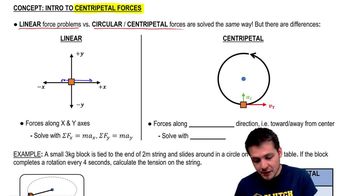Here are the essential concepts you must grasp in order to answer the question correctly.
Centripetal Force
Centripetal force is the net force acting on an object moving in a circular path, directed towards the center of the circle. For an object in vertical circular motion, this force is crucial to keep the object on its path. At the top of the circle, the gravitational force and the tension in the string must provide enough centripetal force to maintain the circular motion.
Recommended video:
Intro to Centripetal Forces
Gravitational Force
Gravitational force is the attractive force between two masses, described by Newton's law of universal gravitation. In the context of the ball swinging in a vertical circle, the gravitational force acts downward and influences the tension in the string. At the top of the swing, this force must be balanced with the required centripetal force to prevent the string from going slack.
Recommended video:
Gravitational Forces in 2D
Angular Velocity
Angular velocity is a measure of how quickly an object rotates around a central point, expressed in radians per second. In this scenario, the minimum angular velocity (ωₘᵢₙ) is the speed required to ensure that the ball maintains its circular path without the string going slack. This concept is essential for deriving the expression for ωₘᵢₙ based on the forces acting on the ball.
Recommended video:
Intro to Angular Momentum




